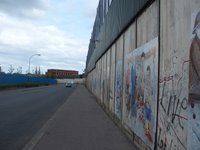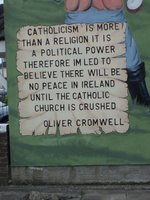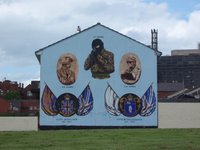
In my musings about the sectarian violence in Belfast I claim to be nothing more than an observer, albeit one who lived in a quiet suburb of London during the IRA's bombing campaign on the mainland. This is no grand gesture of peace and reconciliation. After all, given the opportunity to write graffiti on the division wall, I wrote "Nick - Palace Through and Though 28/5/06". And I wasn't referring to the monarchy.
1pm and settled on the back seats of a black cab, with Patrick ("Pat - that's short for Patrick") and forearm tattoo, we attempt to leave on a Political Tour of West Belfast, before up rings Pat's mobile and the chap from the office tells us we have two more for the tour, a touch for us as it makes it so much cheaper, and in they hop, two 20-somethings from Georgia, slam down the backwards-chairs and off into the traffic around City Hall.

So Pat's tour consists of a detailed account of history, viewed from the places in which is was made and continues to be commemorated, and the first stop a huge pile of pallets and dead sofas, on the Shankill Road, which will burn on the night of July 11th, as Protestants celebrate the victory of King William over James II at the Battle of the Boyne. Then to an open, grassed area in what is the middle of Protestant Belfast; from our taxi point we saw five rows of terraced houses, all with murals; one, seemingly quite old, an iconic picture of King James II, on his knees, wounded, with William rearing up on a white horse behind; and one of Lord Protector, Oliver Cromwell, and featuring a famous quotation about there not being peace in Ireland until the Catholic Church is crushed (although, as Pat pointed out, Cromwell was fiercely anti-Monarchist; so we have a group loyal to the English throne deifying a character who succeeded in toppling the monarchy, albeit only for a short time).
But the more poignant murals depicted scenes from recent times.
Firstly, and with a gun barrel that "follows you round the square", a masked UVF gunman.
Secondly, two murals dedicated to leading members of protestant paramilitary groups. One guy, a smiling character with large glasses, stared down from a turquoise background; he looked like a family man. He died in 2000, during the ceasefire. The other guy was a man of only thirty, a raging bull type, who was killed four years ago.

Pat had pointed out that, during the ceasefire, many of the paramilitary groups - on both sides - had turned in one themselves. Whilst we were there a story emerged about informants, one involving a leading member of Sinn Fein; many alleged informants had been beaten and killed during recent years, including one guy whose location was exposed by the local paper, only for him to be killed five days later. Remaining resident in a City in which he was perceived as an informant was hard to fathom.
Pat also made the observation that, as Africans and Eastern Europeans had moved into the area, the people of Ulster had shown themselves to be intrinsically racist.
I'll write a bit more about the fence, the Catholic Falls area, the memorial gardens and the Irish flag later.

No comments:
Post a Comment